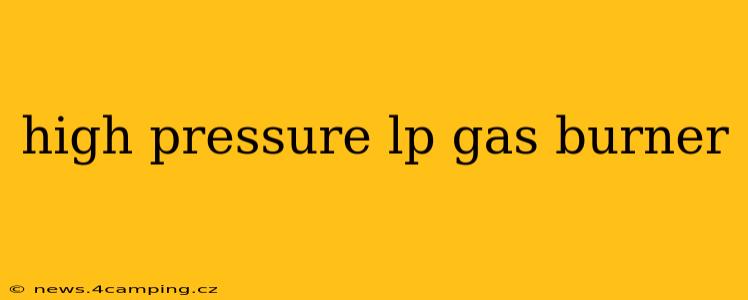High-pressure LP gas burners offer efficient and powerful combustion, making them ideal for various industrial and commercial applications. Understanding their intricacies, advantages, and considerations is crucial for safe and effective operation. This comprehensive guide delves into the key aspects of high-pressure LP gas burners, answering common questions and providing valuable insights.
What are High-Pressure LP Gas Burners?
High-pressure LP gas burners utilize liquefied petroleum gas (LPG), such as propane or butane, at pressures significantly higher than those used in low-pressure systems. This higher pressure allows for greater control over the gas flow and air-fuel mixture, resulting in more precise flame control and enhanced combustion efficiency. They are typically found in industrial settings where high heat output and precise temperature regulation are required.
What are the Advantages of High-Pressure LP Gas Burners?
Several key advantages make high-pressure LP gas burners a preferred choice in many industrial applications:
- Increased Efficiency: The precise air-fuel mixing and controlled combustion lead to higher thermal efficiency, minimizing fuel waste and reducing operational costs.
- Higher Heat Output: Compared to low-pressure systems, high-pressure burners deliver significantly greater heat output, making them suitable for demanding applications.
- Improved Flame Control: The ability to precisely regulate gas flow allows for accurate temperature control and consistent heat output, crucial for processes requiring specific temperature ranges.
- Versatile Applications: High-pressure LP gas burners are adaptable to a wide range of applications, from industrial heating processes to large-scale cooking equipment.
- Clean Combustion: When properly adjusted, high-pressure burners produce cleaner combustion, reducing harmful emissions.
What are the Different Types of High-Pressure LP Gas Burners?
Several designs cater to different needs:
- Premix Burners: These burners mix the gas and air before combustion, resulting in a stable and efficient flame. They are common in industrial furnaces and kilns.
- Diffusion Burners: These burners introduce the gas and air separately into the combustion chamber, allowing for a more flexible flame shape and size. They are often used in applications where precise flame control is less critical.
- Surface Combustion Burners: In these burners, the combustion occurs on a catalytic surface, resulting in efficient and clean burning. They are frequently used in specialized applications requiring precise temperature regulation.
How Do High-Pressure LP Gas Burners Work?
The operation typically involves several key components:
- Gas Supply: LPG is supplied from a storage tank under high pressure.
- Regulator: A regulator reduces the high-pressure gas to a usable pressure for the burner.
- Mixing Chamber: In premix burners, the gas and air are thoroughly mixed in a chamber before combustion.
- Burner Nozzle: The mixture is then directed through a nozzle, creating the flame.
- Ignition System: An ignition system ignites the gas-air mixture.
- Combustion Chamber: The combustion occurs within a chamber designed to optimize heat transfer.
What are the Safety Considerations for High-Pressure LP Gas Burners?
Safety is paramount when using high-pressure LP gas burners:
- Proper Installation: Installation must comply with all relevant safety codes and regulations.
- Regular Maintenance: Regular inspections and maintenance are crucial to prevent leaks and ensure safe operation.
- Ventilation: Adequate ventilation is essential to prevent the buildup of combustion byproducts.
- Leak Detection: Regular leak checks should be conducted using appropriate detection equipment.
- Emergency Shut-off: A readily accessible emergency shut-off valve is vital for quick response in case of emergencies.
What are the Applications of High-Pressure LP Gas Burners?
High-pressure LP gas burners find applications in a diverse range of industries:
- Industrial Heating: Furnaces, kilns, ovens, and heat treating processes.
- Commercial Cooking: Large-scale cooking equipment in restaurants and catering facilities.
- Drying Processes: Drying materials in various industries.
- Metalworking: Welding, brazing, and cutting applications.
- Chemical Processing: Heating and processing in chemical plants.
How Efficient are High-Pressure LP Gas Burners Compared to Other Fuel Types?
The efficiency of high-pressure LP gas burners is comparable to, and often exceeds, that of other fuel types, such as natural gas, particularly when considering the precise flame control and high heat output. The specific efficiency varies based on burner design and operating conditions.
How Much Does a High-Pressure LP Gas Burner Cost?
The cost of a high-pressure LP gas burner varies widely depending on its size, capacity, features, and manufacturer. Prices range from hundreds to thousands of dollars, and professional installation adds to the overall cost.
This comprehensive overview provides a solid foundation for understanding high-pressure LP gas burners. Always consult with qualified professionals for installation, maintenance, and safety procedures. Remember, proper operation and maintenance are vital for ensuring safe and efficient use of these powerful tools.
